I know you.
You’re a leader, educator, and coach. You change the world by helping others become the best leaders they can be—offline and online.
Did I get it right?
I also know why you’re here. You want to learn how to make a leadership style quiz. A leadership style quiz will connect your services to your clients interactively. Imagine growing your business—with a quiz!
In this guide, I’ll teach you everything you need to know about making a leadership style quiz, like:
1. What is a leadership style quiz?
2. Why make a leadership style quiz?
3. What are the three basic leadership styles?
4. What’s the best leadership style?
5. 4 types of leadership style quizzes
6. Before you create a leadership style quiz
7. How to create a leadership style quiz
8. 15 leadership style questions
Let’s get started!
What is a leadership style quiz?
A leadership style quiz tells people what leadership style they practice and how to develop it.
Most people fit into one of the three leadership styles—autocratic, democratic, and laissez-faire. But nowadays, more leadership styles are forming. You might be a coach or a transformational or transactional leader!
So, now you know what a leadership style quiz is, but why should you make one?
Why make a leadership style quiz?
Business coaches, universities, and other educational institutions do great with leadership style quizzes.
Business Coaches—You’re helping your clients become business leaders, so why not use a leadership quiz to guide them?
Universities—Most post-graduate schools, like MBA programs, offer leadership courses. If you’re in this realm, you could use a quiz to direct prospective students to your programs.
All in all, if you implement leadership practices in your business, you’ll do great with a quiz—especially if you own an online business!
Most of our clients are online business owners, and they do phenomenal with the quizzes—mainly because a quiz is the ultimate lead magnet. Using a quiz funnel, you can guide users from your quiz to your sales through email.
And if you’re thinking, Can a quiz really attract more subscribers, sales, and loyal customers? You can check out our case studies and see for yourself!
What are the 3 basic leadership styles?
In 1939, a psychologist named Kurt Lewin went on a journey to find the most common leadership styles. The three styles he found were autocratic, democratic, and laissez-faire.
Each style is different, so I’ll describe them in detail.
1. Autocratic leadership style
Also known as the authoritarian, an autocratic leadership style makes decisions without any input from their team. They’re the boss, and that’s that!
Some common traits of an autocratic style are rigid, demanding, and stubborn. But how do these traits play out? Let’s go over a scenario.
Lynn is the new assistant manager of Kayla’s Bakery. She loves everything about baking and serving quality food. She starts her first day in a couple of hours, and she’s SO excited!
“I’d be careful about that bakery, Lynn,” Lynn’s friend, Claudine, says. “Your interview seemed intense.”
Lynn thought back to her interview, where Kayla grilled her with 25+ questions on her experience as a manager.
“Ah, don’t worry about it, Claudine. I think Kayla just had a bad day! Besides, I have a lot of great ideas for her bakery. She’s going to love me.” Lynn shrugs off Claudine’s warning as she heads to her car.
Once Lynn arrives at the bakery, she walks in with a big smile on her face, “Hey, team!”
Her coworkers look at her with wide eyes, and Kayla, the owner, raises an eyebrow. “Lynn, we’re in a meeting right now, and you’re one minute late. It looks like I already have to dock you as an assistant manager, huh?”
Lynn’s hands start to shake, “Oh, I’m sorry, Kayla, I….”
“And you’re still interrupting my meeting! I don’t have time to listen to your excuses. Sit down and listen to this week’s schedule.”
“Okay, I apologize. But I also brought some ideas I thought you’d like!” Lynn says.
“I don’t take ideas, Lynn. I’ve been running this bakery for twenty years, and it’s successful because I’m in charge. Now sit.”
After reading the scenario, you can see how power-hungry an autocratic style can get. As long as they’re in charge, they’re happy.
Some pros of the autocratic style are:
- They aren’t afraid to speak up.
- They create a structured environment for their team.
- They are detail-oriented.
And the cons:
- Workers under an autocratic style are often stressed out.
- Setting very high standards leads to disappointment.
- Who wants to work with someone who never collaborates?
All in all, the autocratic style fails at listening and understanding their team’s ideas. Their strict environment might work for the short term, but it usually leads to burnt-out team members over time.
2. Democratic leadership style
Democratic leaders live by the saying, “All for one, and one for all.” They believe the best decisions are made when everyone participates.
A democratic leader is best described as group-oriented, fair, and respectful. In most democratic environments, each member will contribute their ideas and vote on the best one. The leader is there to facilitate discussions and declare the final decision.
Here’s what a democratic style looks like in real life.
“Okay, team,” Coach Jen says to her varsity basketball team. “Our next basketball game will determine if we make it to state. As most of you are seniors, I know this is your last chance of getting that trophy. So I want to know what you think will bring us there.”
“Well,” team player Nadine says, “I don’t know about everyone else, but I’m up to practice twice a day until the game. I want that title.”
“Yeah, I agree with Nadine!” Brooke exclaims. “But I also wouldn’t be able to make it a few times because I have to take my brother to school.”
“Okay, well, how about we push our practices to twice a day, and we can choose the best schedule for everyone on the team.” Coach Jen proposes. “How does that sound?”
Everyone on the team agreed and collaborated on a schedule. While a few players couldn’t make a couple of practices, most of the team was there and ready to bring their A-game.
It’s nearly impossible to make everyone in a room happy, but you can get close with democratic leadership. Plus, team members are more satisfied when they can share their ideas.
The pros of a democratic leader are:
- Everyone contributes to the final decision.
- There’s a higher level of group commitment.
- Everyone is working toward the same goal.
The cons:
- You can’t guarantee a 100% satisfaction rate.
- Poorly led discussion can lead to unproductive and lengthy meetings.
Democracy is a great way to lead big teams, but the leader has to make sure they’re guiding the group to a decision. If not, it’ll get chaotic.
3. Laissez-Faire
Also known as the free-rein leadership style, think of laissez-faire as the “cool parent.” They stay out of the way and let their team make their own decisions.
This laidback style is often described as hands-off, trusting, and independent.
“Okay, team, I have an idea about your next project.” Nathan is the founder of Yes Coach, a certification program for life coaching.
“When you’re coaching others to find their purpose, they’re going to you for advice—not me,” Nathan continues. “I want you to think of three tools to help your future clients find their path.”
“We’ve never done anything like this before, Nathan,” Veronica says. “Do you have any advice on how to find these tools?”
“I hear you, Veronica. I’ll send each of you some background on this project, but I essentially want you to use your creativity. Once you’re done, I’ll open for discussion and share the tools I use for my clients. You have until next week!”
The laissez-faire approach pushes people to find solutions on their own. It encourages critical thinking and independence.
Some pros of this leadership style are:
- People are encouraged to think critically.
- Workers can finish on their schedule.
- Workers are pushed to think on their feet.
The cons:
- Without morale, motivation can be lost.
- Hands-off doesn’t work well when attention to detail is needed.
- High-pressure situations need a decision-maker.
To sum up, the laissez-faire style is great if your team has expertise and experience. It’s not so great if a team is entirely new to the environment.
Other leadership styles
If you search “leadership styles” on Google, you’ll find more than three. Keep in mind that other types stem from the three main types mentioned above, but I’ll go over a few.
Servant—Serving first and leading second, this style focuses on what their team needs to get the job done. A majority of their energy goes to helping their team succeed.
Transformational—Uses inspirational speeches to motivate their team. Most of these leaders have a clear vision of what’s ahead and communicate that vision to their team.
Transactional—This style uses rewards (salary, promotions, raises) to motivate employees. They give each member a list of tasks to complete in exchange for a reward.
What’s the best leadership style?
After finding the three leadership styles, Kurt Lewin conducted a study with school children where an autocratic, democratic, and laissez-faire teacher taught three separate groups of children.
And the results?
He found that children under democratic leadership were the most effective. Plus, the children themselves inspired others to perform well.
So Kurt finds democratic leadership as the best style, but I also want to bring up situational leadership.
Situational leadership doesn’t believe everyone should practice one style. But instead, every situation calls for a different leadership technique.
For example, a big project and short deadline call for autocratic leadership, while a creative and hands-on project calls for laissez-faire.
Situational leadership is great because you’re using the pros of each leadership style for the right situation.
As you create your leadership style quiz, consider which styles you want to include in your results. Feel free to create your own versions of each style, too!
4 types of leadership style quizzes
If you’ve never created a quiz before, then you’re probably dying to see a few examples. What do leadership style quizzes look like, anyway?
1. What’s your natural leadership style
Atlassian is behind project management tools like Trello and Jira. As a proponent for productive workdays, they created a “What’s your natural leadership style?” quiz.
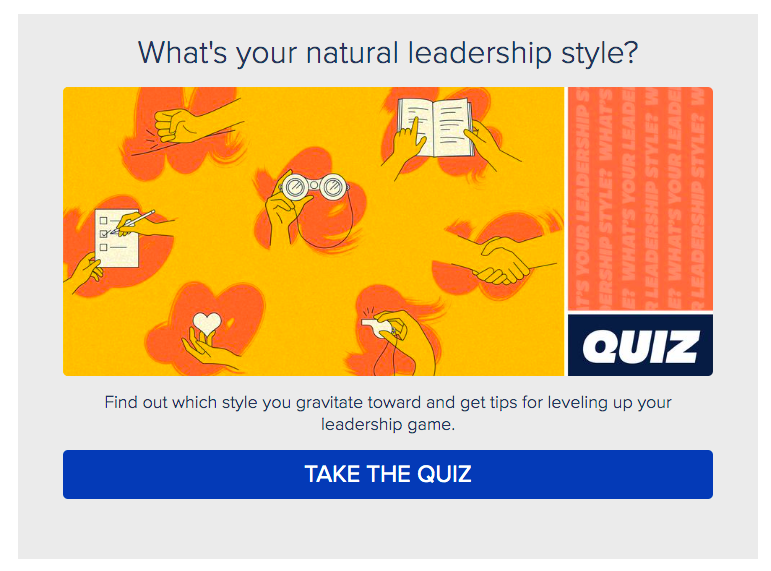
The best part about Atlassian’s quiz is the questions.

This question figures out how you communicate with your team without directly asking, “How do you talk to your team?” Atlassian does a good job of asking insightful questions without being obvious.
Some other questions they ask are:
- Your favorite part about being a leader is…
- How do you make decisions with your team?
- How do you deal with poor performance with your team?
- What best describes your approach to planning a vacation?
- Where do you feel most at home?
2. What’s your feminine leadership style
If you’re a coach, then you’ll love this quiz. Jessica Dowches-Wheeler uses a “What’s your feminine leadership style” quiz to encourage clients to find their dream career.

As most of her clients are women, she adds a twist to her quiz by adding “feminine leadership” to it. Consider your target audience—is there a way to customize your quiz and suit their needs?
The best part about Jessica’s quiz is her result page.

Colorful fonts and images make your results page pop. We’ll go over the rest of this result page later in this article.
3. What type of leader are you?
Brandman University uses a “What type of leader are you?” quiz to promote their academic programs.

This example shows how the education industry can attract more students with a quiz. And by education industry, we mean:
- Online courses
- Online certifications
- In-person courses and certifications
- Universities
- Extracurricular activities
Do you have an online or in-person program you can promote with a leadership quiz?
4. What’s your leadership ability?
The last leadership quiz we’ll talk about is Tony Robbins, “What’s your leadership ability?”

Tony takes a different approach from the normal “What’s your leadership style” and divides his quiz into eight categories.
- Listening
- Resourcefulness
- Perspective
- Emotional state
- Decisiveness and confidence
- Vision and courage
- Communication
- Honesty/Integrity
When you build your quiz, ask yourself: How can I make this quiz unique? Are there other frameworks I can use to find my audience’s leadership style?
From looking at each of these quizzes, you now know:
- How to customize a leadership style quiz for your audience
- How to promote your online courses, programs, and coaching services
- How to integrate a personality framework
So, how do you create a leadership style quiz, anyway?
Before you create a leadership style quiz
A convert-worthy quiz comes with a plan. Let’s talk about what you need to know before designing your quiz.
1. Build an angle
You aren’t taking your quiz and neither is your family, friends, or colleagues. Rather than basing your quiz on what you think is helpful, understand your audience’s needs first.
Looking back at the four leadership style quiz examples, Jessica created a leadership quiz for women. And Tianna created one using the enneagram. They both used a different angle to target their audience.
To build an angle, ask yourself the following questions:
- What does your audience need to know about leadership styles?
- What type of questions would they find helpful?
- Does my audience fall into a certain demographic (ie. gender, age, occupation)? Can I customize my quiz to that demographic?
You should also consider your industry. If you’re a coach, how will your quiz connect to your services? Or, if you work at a university, then how will your quiz promote your courses?
Make your quiz as specific to your audience as possible to get the best results.
2. Ask questions
Once you know your angle, you can create your questions! Questions are the bread and butter of your quiz. If you don’t ask the right questions, users will get confused or (gasp!) even worse, leave your quiz.
So how do you ask good questions?
It mainly depends on your audience and what they want to know. Go through your content, comments, and social media and take note of:
- What your audience asks you about
- What they struggle with
- What they desire
Overall, most quiz questions are fun, thought-provoking, and provide a different perspective. Let’s go over each of these traits, starting with “fun.”
Fun—Remember the good old days when you would take a quiz in a magazine with your friends? It was fun, right?
A magazine quiz is similar to an online quiz. They’re fun and provide instant feedback.

The question, “Which animal do you most identify with?” doesn’t have anything to do with leadership styles. Or does it?
Take a look at each answer. If you identify with a horse, then you think of yourself as “loyal, productive, and a problem-solver.” Or, if you identify as a tiger, then you’re “independent, proud, and powerful.”
Do you see what this quiz-maker did?
They took the generic “Describe yourself in three words” (which everyone hates answering) into a fun question.
Thought-provoking—A thoughtful question doesn’t mean using complex language and long sentences. It can be something like below:

The question, “Where do you feel most at home?” gets users thinking where they feel most comfortable, which says a lot about your leadership style.
Plus, it encourages you to think for more than ten seconds. They might have to take a minute to choose their answer because it’s insightful.
Different perspectives—The best questions offer a different angle on a subject.

Asking “Others have depended on” is different from the usual “What are your best traits?” question. It offers a new angle.
Another way to ask different questions is by changing the format. A few question formats include:
This or that—Creativity or reliability?
True or false—You live by the rules, true or false?
Scenario—Your coworker comes to you with a problem while you’re in the middle of a project. What do you say?
I’ll go over 15 leadership style questions to include in your quiz, too!
3. Build a results page
Your results are what your quiz-takers have been waiting for! Plus, they connect users to your website, content, and services.
We’ve found that our most successful clients build ah-mazing result pages. A few traits of an amazing result page include:
Descriptive—You’re not describing someone’s quiz result in a sentence or two. You’re writing paragraphs about their strengths, weaknesses, and desires. Your quiz-takers should finish reading and think, They read my mind! How do I get more of their content?
Encouraging—Results are exciting, so get your users pumped with creative language, in-depth info, and fun images!
Aligned with a CTA—Don’t be shy about sharing your services. Warm-up your audience with jam-packed value. Then tell them why and how your business will develop their leadership style.
As an example, let’s dissect Jessica’s “What’s your feminine leadership style?” result page.

Notice how the result is “Ceiling Smasher.” I don’t know about you, but I’m intrigued to learn more about being a ceiling smasher. So let’s read more!
Jessica writes a detailed summary of a ceiling smasher with encouraging language. Keep this in mind when you build your results page—the last thing you want to do is discourage users with negative copy.
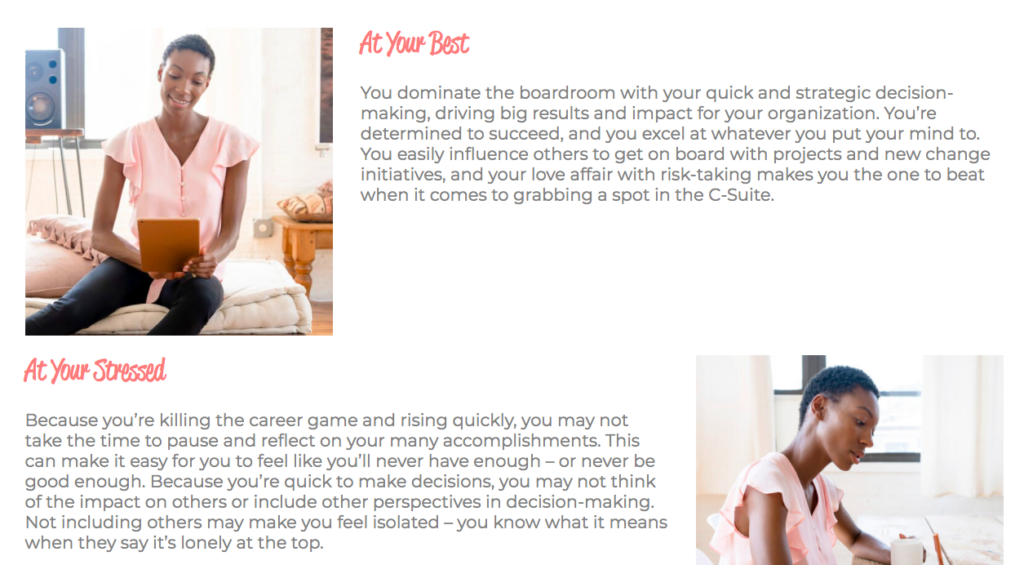
The description isn’t done just yet. Jessica adds an “At Your Best” and “At Your Stressed” section to define the user’s strengths and weaknesses. It’s important to tell your quiz-takers how their style makes them thrive and struggle.
I also like how she adds images to spruce up her copy.
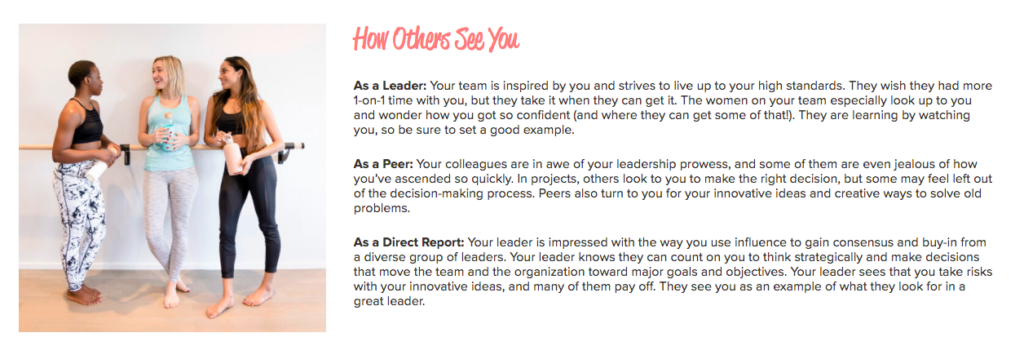
And her description is still going with a “How Others See You” section. Talk about another perspective—your leadership style is also about how OTHERS see you—as a leader, peer, and direct report.

She even adds a section called “A few more things” to offer as much value as possible. I like how she encourages users to interact with other leadership styles she created.
Most result pages end after describing the quiz result. This is a BIG no-no in the marketing world. If you stop here, your audience won’t know how to connect with you.
What you need is a call to action. A call to action tells users their next step. It can be something as simple as reading a blog post to signing up for a program.
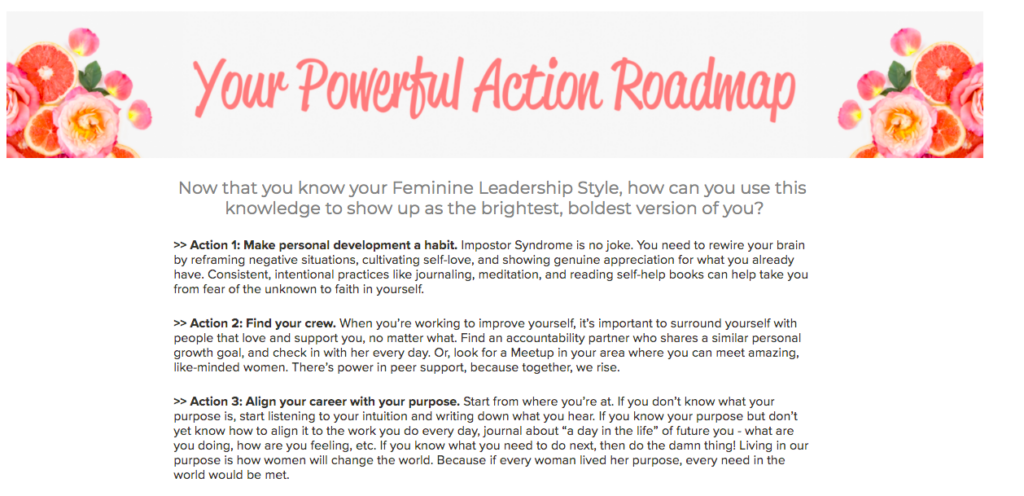
Jessica added two free resources as a call to action: a roadmap and a feminine leadership style workbook.

Freebies are the best way to turn quiz-takers into leads. Especially interactive freebies, like a workbook!
Jessica created a 7-day email sequence to get more email subscribers. We talk more about building an email sequence in this guide: How to build the perfect follow-up email sequence.
Overall, Jessica’s results page includes:
- An insightful description of each type
- Free resources
- A call to action
You might also want to add a quick introduction of you and your biz. This way, your audience will get to know who you are, too!
For more result page tips, check out our guide, How to Create Quiz Result Landing Pages that Dazzle Your Audience.
4. Promote your quiz
Your audience won’t see your quiz if you don’t promote it, right? It’s important to plan a promotion strategy.
Our software will help you promote your quiz with:
Social media—A simple tweet to your followers can spread your quiz like wildfire. You can implement your quiz into a social media post with our complete guide to promoting quizzes on social media.
Facebook ads—Using Facebook pixel, you can get your quiz in front of the right people with paid ads. Kristen Poborsky talks about her quiz success using Facebook ads in this case study. You can learn how to implement Facebook Ads with our guide: How to Make a Facebook Quiz Ad.
Email marketing—Email is our favorite way to put quizzes on blast! Send your quiz to your current subscribers. And don’t forget to build an email opt-in for new quiz-takers.
Landing pages—Our software integrates with landing page companies, like Leadpages and Instapage. Check out our post on how to build a landing page to get the full scoop.
So now that you know how to build an angle, ask the best quiz questions, and promote your quiz, let’s get to the designing!
How to create a leadership style quiz with Interact
When you sign up for a free Interact account, you’ll have access to:
- Unlimited quizzes
- Hundreds of quiz templates
- Customized design
And with our other pricing options, you can access email marketing integration, analytics, conversion tracking, branching logic, and more!
If you haven’t signed up with Interact, you can do so here and follow along with our tutorial.
Table of contents
1. Pick a template
2. Choose a design
3. Create a cover page
4. Design question pages
5. Build a results page
6. Correlate questions and answers
1. Pick a template
You can either choose one of our quiz templates or start from scratch. I’ll teach you how to do both options, starting with the quiz template.
On your quiz dashboard, click Create new quiz.

You’ll be taken to a list of quiz templates to choose from. In this tutorial, I’ll use the “What’s your leadership style?” template.
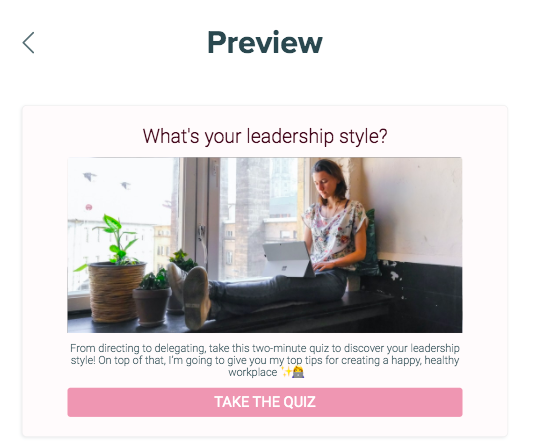
To start from scratch, click Start from scratch at the bottom of the page. This feature lets you create your quiz without a template.

2. Choose a design
Our templates are designed with a color scheme, but you can change it with the menu at the top.

This menu will help you throughout the design process.
Feel free to choose a different set of colors. You can also change your font by clicking T and add a logo by clicking the photo icon.
3. Create a cover page
Your cover page is the first thing people see about your quiz, so make it eye-catching!

Let’s start with the title. I suggest framing your title as a question. People love to answer questions, so instead of using “Find out your leadership style,” use “What’s your leadership style?”
Next is your cover image. If you click Edit cover image, you can upload a photo or choose from our gallery.
Now let’s talk about the quiz description. All you have to do is describe:
- What your quiz is about
- How it benefits users
- What they get in return (your freebie)
You can also add incentives like “it only takes 60 seconds!” or “You’ll transform your workplace in 10 questions” to your description. Your goal is to point out the benefits of taking your quiz.
4. Design question pages
Most questions look something like the below.

But you can spruce things up with a question image.

Click Edit to upload another photo or choose from our selection. You can also add images to your answers!
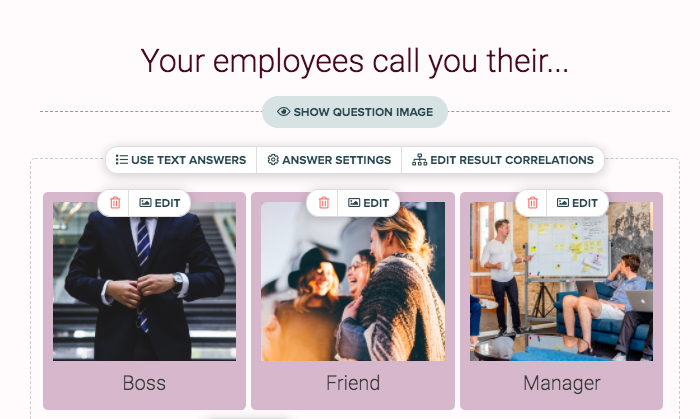
Image answers add some pizzazz to your questions and make them look more fun.
5. Build a results page
We already went over building a results page, so this part will be easy!

When you insert your results page copy, you can use the additional menu at the top to format your text, images, and links.
6. Correlate questions and answers
To offer accurate quiz results, correlate your questions with your answers. You can do this with our correlation feature.
Head to your quiz questions and click Edit result correlations.

From here, choose which result goes best with your answers. Feel free to pick more than one result for each question. And don’t forget to correlate EVERY quiz question.
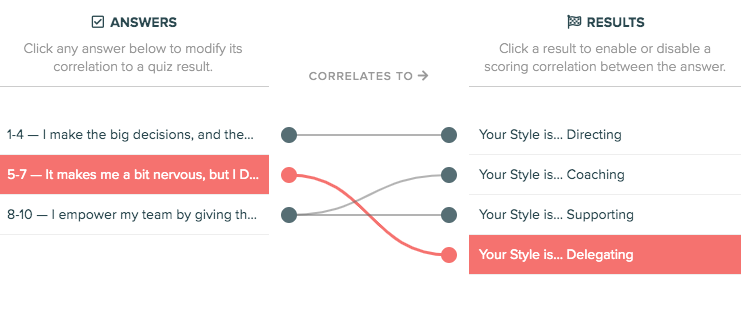
Click on the eye icon to preview your quiz, and then click Publish when you’re ready!

That’s it! You’ve officially created a leadership style quiz.
15 leadership style questions to ask
Before ending this guide, I’ll leave you with 15 questions you can ask in your leadership style quiz! It doesn’t matter if you’re a coach or an educator, these questions are great for anyone.
The below 15 leadership style questions are based on the three leadership styles—autocratic, democratic, and laissez-faire.
1. You’re happy with how a meeting goes when:
- My team listens to me and takes notes! It’s nice knowing they respect my authority.
- Everyone is involved! I want my entire team in on our goals.
- It gets canceled—I avoid holding meetings when I can!
2. Ah, it’s finally the weekend! But wait—your employee messages you with a big work issue. What do you do?
- I get irritated. I specifically told my employees to leave me alone until Monday.
- I tell them to wait until Monday and we’ll figure it out together.
- I tell them to figure it out themselves. That’s why I hired them!
3. What’s your go-role in a group project?
- The facilitator—Call me bossy, but I LOVE telling people what to do.
- The builder—I’d rather put my energy into building something than collaborating with the team.
- The planner—My specialty is creating action plans. 1,2,3… GO!
- Ugh… I hate group projects! Can I opt-out?
4. You and your friends are going to Hawaii! How do you plan your dream vacay?
- I let my friends plan everything and enjoy the ride.
- I ask my friends what they want out of the trip and plan tons of events around it.
- I make a detailed itinerary and follow it, with or without my friends.
- I host a vacation planning party so everyone can chime in!
5. What motivates you to get through a workday?
- Changing people’s lives. Nothing will get done if I sit around and do nothing.
- My vision board and how happy I’ll be when everything comes true.
- Money—I got bills to pay!
- Getting to hang out with my family and friends after work! I love social time.
6. You have a 5-year vision of your career path.
- True—I’m motivated to get there!
- False—I’m still figuring out my plan.
7. Your team always comes to you for…
- Answers
- Advice
- Collaboration
- Lunch plans
8. Who do you aspire to be like?
- Elon Musk—He’s a true visionary.
- Oprah Winfrey—She knows how to connect with people.
- Warren Buffet—He stays off the radar and still makes TONS of cash!
9. Telling people what to do is…
- Necessary. The job won’t get done without a boss, duh!
- Annoying. Why can’t everyone work on their own terms?
- Unnecessary. Everyone should have a voice about what goes on in the workplace.
10. What did you want to be when you grew up?
- A doctor! Saving people’s lives is a must for me.
- An actor. I love entertaining people and making them laugh.
- An astronaut. Being in space sounded so cool, and it’s WAY different from anything on this planet.
- A wedding planner. I love planning and helping people’s dreams come true.
11. It’s evaluation time! What are your team members saying about you?
- You’re too busy envisioning the future to worry about everyday tasks.
- You’re friendly around the workplace but are afraid to take charge.
- You’re great at planning projects but struggle to implement them.
- You take charge when you can, even when it’s unnecessary.
12. You make decisions by…
- Flipping a coin. Whatever happens is destined to be.
- Making a pros and cons list.
- Imagining how each decision would play out and then choosing the best outcome.
- Ugh—I try to avoid decisions as much as possible.
13. What would your “work superpower” be?
- Invisibility—Working without talking to people? Yes PLEASE.
- Super focus—I get so distracted by people and events at work!
- Typing as fast as I think. I am FULL of ideas.
14. Your boss asks you to lead the next presentation. What are your thoughts?
- I’ve been waiting for this day! I can’t wait to share all of my ideas with everyone.
- I’m nervous but excited to lead the conversation!
- Can I fake being sick that day?
15. What’s your morning routine looking like?
- A business podcast and cup of coffee!
- Rolling out of bed and scrambling to my desk.
- A quick breakfast and to-do list of what I need to get done.
- Some quiet time for myself.
Feel free to include these questions in your leadership style quiz. And don’t forget to check out our leadership quiz templates!
Your next steps
At this point, you know everything there is to know about a leadership style quiz, like:
- What it is and why you should make one
- The 3 main leadership styles
- How to make a leadership style quiz
- 15 questions to include in your quiz
So now that you’ve created your quiz, you can build an email sequence and land those clients! An email sequence will guide users from your quiz to your business goals.
You can get started by reading the posts, How to Write the Perfect Followup Email Sequence, and The Complete List Building Guide.
And if you haven’t already created an account with us, you can do so here.